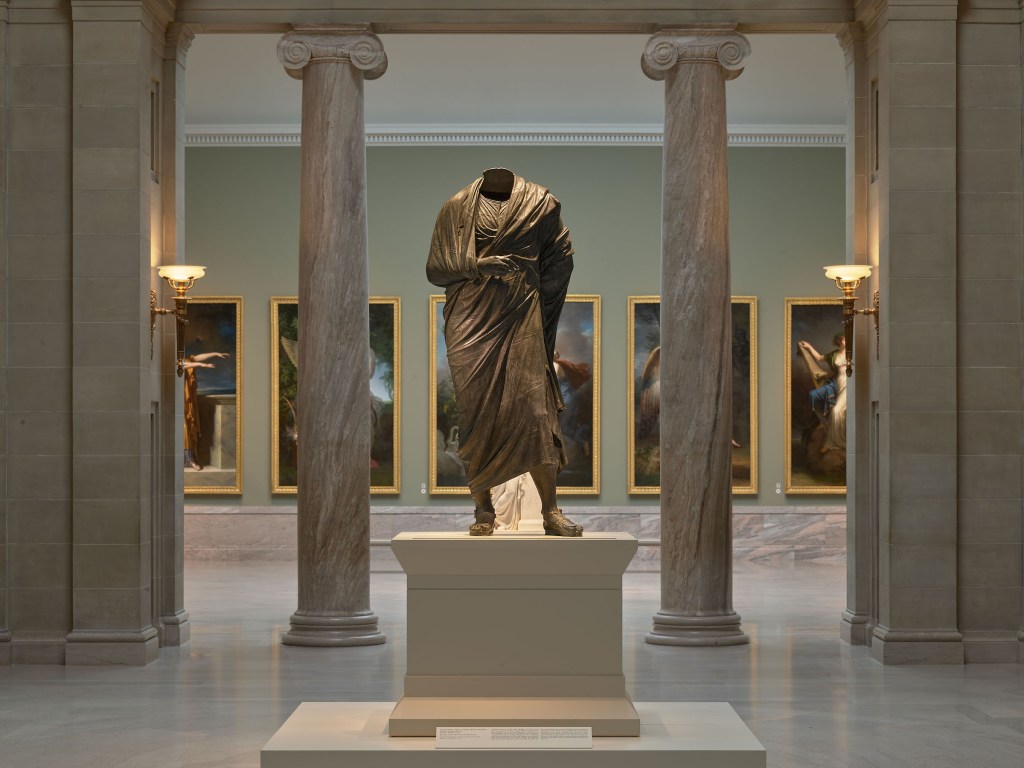A Looted Greco-Roman Statue Goes on Display Before Its Return


A 1,800-year-old, life-sized Greco-Roman statue looted nearly six decades ago from present-day Turkey has gone on its final display at the Cleveland Museum of Art (CMA). Following more than a year of legal battles, the headless bronze sculpture went on view earlier this month in the museum’s rotunda, where it will remain through July 8 before it is repatriated.
Estimated to be worth some $20 million, the more than six-foot-tall statue is part of a trove of Roman artifacts originating from the ancient city of Bubon that have been prominently displayed at museums around the United States for decades. The works were initially unearthed from an ancient shrine during the mid-20th century and subsequently smuggled out of Turkey by illicit antiquities traffickers George Zakos and Robert Hecht, according to an investigation by the Manhattan District Attorney.
Despite published research connecting them to Bubon and a request from the Turkish government in 2012 asking for their return, it wasn’t until 2023 that investigators finally seized dozens of these stolen works, many of which were repatriated. But the statue of Marcus Aurelius remained at the CMA.
“This statue was quite unusual for how well-documented its illegal origins were,” museum studies scholar Elizabeth Marlowe told Hyperallergic in an email, pointing out that the looters had immediately garnered the attention of Turkish authorities and archaeologists.
In an opinion for Hyperallergic in September 2022, Marlowe referenced the statue’s association with a vacant pedestal in Bubon that bears the etching of Marcus Aurelius’s name.

For more than a year, the artwork was at the center of a lawsuit filed by the CMA against Manhattan District Attorney Alvin Bragg contesting the work’s place of origin and the identity of its subject, thought to be Roman Emperor Marcus Aurelius. In February, after extensive forensic analysis, soil comparisons, witness interviews, and document research that confirmed the statue had been plundered from Bubon, the CMA finally surrendered the statue.
Before its repatriation, the statue will remain on view at the CMA for nearly three months in a display contextualizing its controversial journey from Bubon to Ohio. The work is presented alongside four panels exploring its creation and iconography, the Bubon archaeological site, recent scientific analysis, and the legal conflict and ethical debates surrounding its acquisition.
“We see the new display as a positive outcome to a lengthy process and an opportunity to share new knowledge and bid this longtime visitors’ favorite farewell,” Seth Pevnick, the CMA’s curator of Greek and Roman Art, told Hyperallergic.
The CMA continues to suggest uncertainties around the statue’s identity, referring to the work as “Draped Male Figure, perhaps Marcus Aurelius” (c. 150 BCE–200 CE) based on the possibility that the statue stood on an uninscribed platform in Bubon rather than the one bearing the emperor’s name.

This final display of the statue notably recognizes the crucial research of Turkish archaeologist Jale İnan, who in 1978 published a scholarly article matching the looted artifacts to the Bubon site.
“It was her publications, starting in 1979, that tied the thefts at Bubon to the statues that were circulating on the American market, including this Philosopher statue,” Marlowe told Hyperallergic.
In the fourth panel of its display, the museum also maintains that the “statue had been publicly exhibited in several other institutions in the United States, the seller claimed to be its rightful owner, and the reported modern history of the sculpture met the CMA standards for acquisition.” The text further notes that the CMA had “received no legal challenges to [the statue’s] ownership until 2023,” although Turkey has been requesting its return since 2012.
“Yes, for the 19 years that the statue was on the market, it had been ‘publicly exhibited in several other institutions,’ but there’s a reason none of those other museums had been willing to risk buying it,” Marlowe continued.
“If the ‘reported modern history of the sculpture met the CMA’s standards for acquisition,’ that only reveals how out of step the CMA’s standards were compared to all the other museums that took Inan’s work seriously and said no to documented plunder,” Marlowe said.





